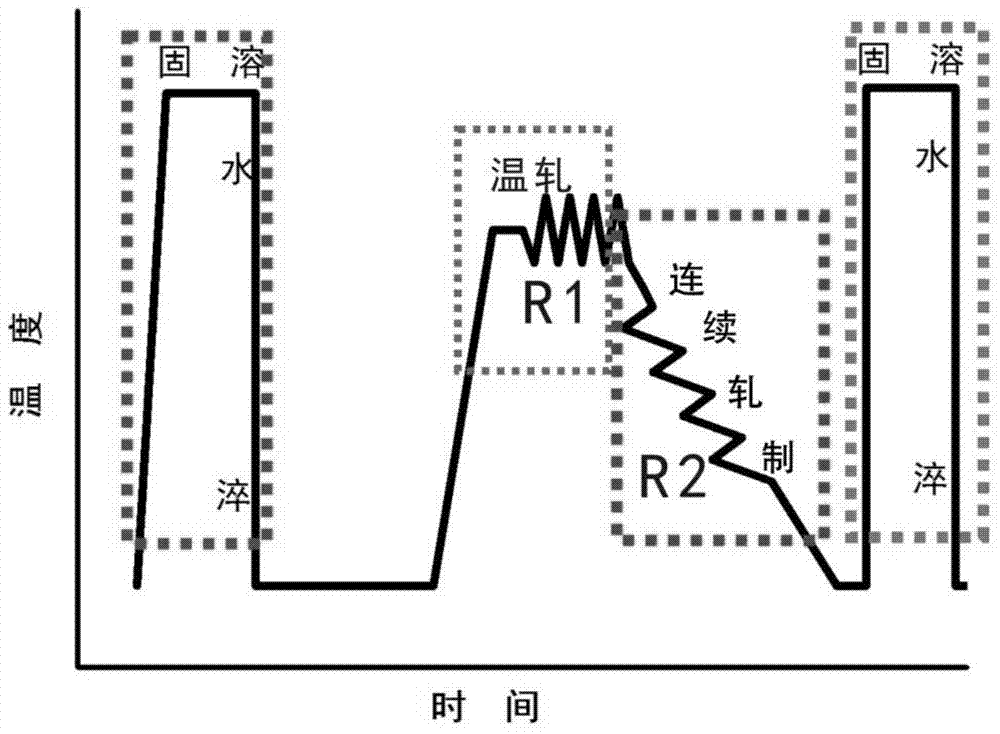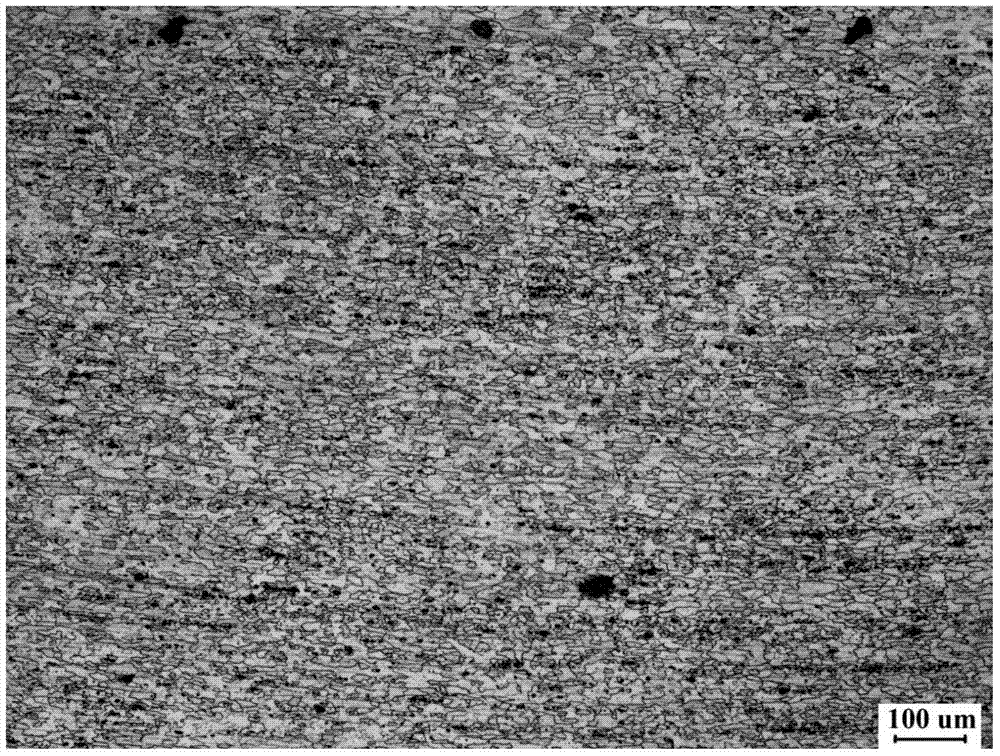Grain refinement method of 7000 series aluminum alloy
A treatment method and grain refinement technology, which is applied in the field of deformation heat treatment of metal materials and grain refinement of aluminum alloy materials, can solve the problems of long process cycle, non-continuous production, and large energy consumption, and achieve reduced operation Difficulty, time shortening, and the effect of increasing longitudinal elongation
- Summary
- Abstract
- Description
- Claims
- Application Information
AI Technical Summary
Problems solved by technology
Method used
Image
Examples
Embodiment 1
[0036] according to figure 1 The mechanical heat treatment process shown uses 7075 aluminum alloy as the rolling material. In order to dissolve the solute atoms into the matrix, the plate was subjected to solution treatment at 475 °C / 1.5 h, water quenched at room temperature, figure 2 It is the metallographic structure of the undeformed initially quenched 7075 alloy. Deformation was realized on an ordinary two-roll rolling mill. The 15 mm thick solid-solution 7075 alloy plate was heated to 350 °C and held for 10 min, and 60% of the deformation was achieved through 6 passes of rolling, in which every two passes were returned to the furnace for 5 minutes ( holding temperature of 350°C), and then continue rolling the plate with 60% deformation on the rolling mill. The rolled plate was subjected to solid solution recrystallization treatment at 480°C for 10 min and 30 min, respectively. Figure 3a and b show the metallographic structures of the two. Figure 3 c and d are the EBSD...
Embodiment 2
[0038] according to figure 1The mechanical heat treatment process shown uses the 7075 alloy that has been solution-treated at 475°C / 1.5h as the rolled material (thickness 15 mm). It was heated to 450°C and held for 10 min, and 50% deformation was achieved through 5 passes, and it was returned to the furnace for 5 min every two passes, and then continued to be continuously deformed on the rolling mill with deformations of 60% and 90%, respectively. Reheat. The final rolled sheet was subjected to 480°C / 0.5h solid solution recrystallization treatment, and Fig. 6a and b respectively show the fine-grained structures obtained by the two. The alloy with continuous deformation of 60% is subjected to 480°C / 0.5h solution treatment and T6 aging treatment. At this time, the longitudinal and transverse strength of the plate are equivalent to those in Example 1, and the longitudinal and transverse elongation of the plate are 17.5% and 18.2%, respectively. This condition can be seen It als...
Embodiment 3
[0040] according to figure 1 The mechanical heat treatment process shown uses the 7075 alloy that has been solution-treated at 475°C / 1.5h as the rolled material (thickness 15 mm). It was heated to 350°C and held for 10 minutes, and 90% of the deformation was achieved through 8 passes. Every two passes were returned to the furnace for 5 minutes, and then the continuous deformation of 70% of the deformation was continued on the rolling mill without returning to the furnace. The final rolled plate is treated at 480°C / 0.5h and 120°C / 24h to obtain a fine-grained structure such as Figure 7 As shown, the longitudinal and transverse strength of the plate at this time are equivalent to those in Example 1, and the longitudinal and transverse elongation of the plate are 17.4% and 16.8% respectively. It can be seen that this condition also improves the strength and plastic anisotropy of the plate (Table 1) .
PUM
| Property | Measurement | Unit |
|---|---|---|
| Average grain size | aaaaa | aaaaa |
Abstract
Description
Claims
Application Information
 Login to View More
Login to View More - Generate Ideas
- Intellectual Property
- Life Sciences
- Materials
- Tech Scout
- Unparalleled Data Quality
- Higher Quality Content
- 60% Fewer Hallucinations
Browse by: Latest US Patents, China's latest patents, Technical Efficacy Thesaurus, Application Domain, Technology Topic, Popular Technical Reports.
© 2025 PatSnap. All rights reserved.Legal|Privacy policy|Modern Slavery Act Transparency Statement|Sitemap|About US| Contact US: help@patsnap.com



